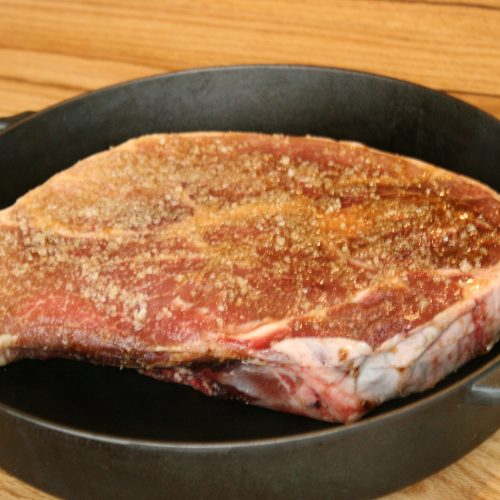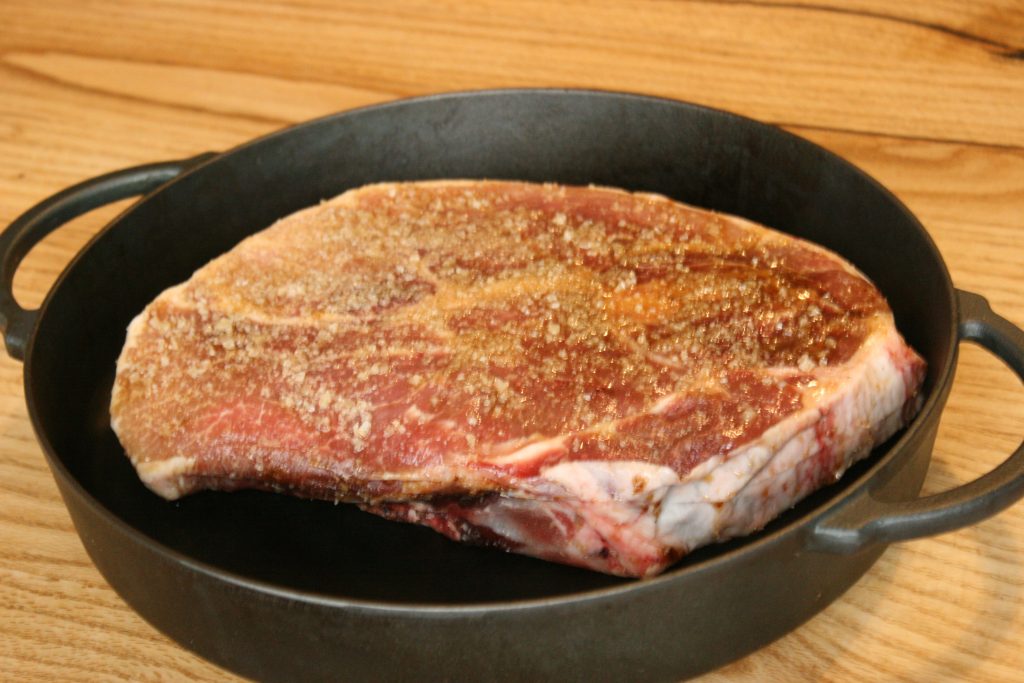Have you ever tried a pasture raised, naturally cured, smoked ham? It’s phenomenal compared to what you get in the store. What’s more exciting is how many people have reported to me that conventional pork upsets their stomach, but they can have ours. Since these hams are naturally cured, maybe it will be a good option for you. I read a research study done by the Weston Price Foundation that suggested that pork that was naturally cured or fermented was easier to digest (according to some blood work they observed in participants). I found that very interesting! I have had several requests to share how we make our naturally cured ham, and I’m always happy to share what we are doing.
There are many ways to cure meat. Curing is simply controlling the water to make the product safe for storage without the use of a freezer or refrigerator. That was my goal when I first started this process, but our family found the meat was way too salty. The Aurora Meat Block helped us to see that we don’t have to get it to this point thanks to refrigeration and freezers. We don’t need to have hams hanging from the ceiling in our kitchen like the olden day. At least not yet! In other words, we don’t have to get all the moisture out to prevent mold and spoilage due to room temperature storage. We can treat it like a fresh meat. This allows me to shorten up the cure time. Actually, I can’t call this cured unless it uses commercial nitrates/nitrites, but I’m going to use this term anyways. Even celery powder, a natural source of nitrites is not considered a “cure.” For most of history these commercial cures weren’t even used, but that’s a story for another day.
I’m always on the lookout for old books on meat preservation. I inspect them with excitement, only to discover that it was the same rhetoric I had heard everywhere. “You need to use commercial nitrites in order to avoid botulism in the meat.” I didn’t give up, because I was convinced that there was a better way. I had heard that processed meats were carcinogenic, but I had to wonder if it could be the way they were produced. Before refrigeration and freezers, people cured meat with salt and no nitrites. The industry has done a great job at instilling fear in me about this process in the past, but after doing a lot of research and natural curing for our family, I feel very comfortable with it.
You might be thinking, “What about the risk of botulism? Isn’t that why we use the nitrites?” I have done a lot of research on this too, and I’m not convinced of the risk, but this is my own personal conviction. The owner of the Farmstead Meatsmith said something like this, I have never found a case of someone dying of botulism from meat. The cases you hear are coming from restaurants that left baked potatoes in aluminum foil for days and then made soup out of them. He also said there are many countries that still do traditional natural curing. You can check him out here. He has a little different process that results in a saltier product, but many people love it.
While we all need to weigh the risks/benefits of what we do, I’m comfortable with my process, because I’m not breaking any rules. First my fresh meat is kept in the refrigerator for five days, which is an acceptable time frame for fresh meat. Second, I either smoked this while it was cold like a refrigerator outside for several hours or in my commercial smoker which cooked the meat, or at least it did until my commercial smoker caught on fire (a little too much multi-tasking on my part). I do want to confess that I’m not an expert in this. I’m simply sharing what we do and why we do it. We live in a fallen world and there’s going to be risks with anything we produce or buy. I must only encourage you to pray and do your own research.
You can cure by removing water from the meat or by fermentation. The process we are talking about today has to do with removing water, and we will do this with salt. When we make our hams, we use three ingredients, natural salt (very important that it is natural, and nothing added), maple syrup, and celery juice powder. We have also used honey instead of the maple syrup which was good, but we all like the flavor the maple syrup gives the ham. We leave this in the refrigerator for exactly five days and turn it and rub it every day. I’m not a huge fan of plastic, but I do use a Ziplock bag to store the ham in the refrigerator, because it’s quick and easy to flip and rub every day. After that time, we rinse the meat thoroughly and either smoke it while cooking the ham, or we do a cold smoke and cook it later.
The celery juice powder will give the meat a pinker color and we thought it changed the texture as well. You can easily do this without the celery juice powder if you want to avoid the nitrates/nitrites. Celery juice powder is made by juicing celery and then adding a culture to it to turn the naturally occurring nitrates into nitrites. There has not been enough research on this to say if this completely transforms the nitrates into nitrites so it’s not recommended to use this for bacon or hot dogs, because of the high heat that they are fried at. The high heat can form nitrosamines if all the nitrates have not been converted, and these are considered toxic to our health. Because of the uncertainty with celery juice powder, I only use this on our hams at this time. I just can’t get the same texture without it. Hopefully I can share more about this in the future and will continue to watch for new studies. I will be posting a picture once this ham is complete and I’m working on a video that I hope to post soon.
Have you tried curing your own meat? How did it turn out? We love to hear from you!

Naturally Cured Ham
Ingredients
- 1/4 cup maple syrup
- 1.2 tsp. celery juice powder or .2 ounces
- 1/4 cup coarse salt Must be natural with nothing added
- 5 pound fresh ham roast
Instructions
- Thaw your ham and then rub maple syrup all over it. Add the celery juice powder and rub that in well. Finish this by adding the coarse, natural salt to the entire piece of meat making sure to get the sides. Place in a Ziploc bag and put it in your refrigerator for 5 days. You may want to put this in a pan in case it leaks. Make sure to flip this bag and rub it all over each day. After 5 days, remove the ham and rinse it off. You can smoke this while it's cooking or do a cold smoke. We have done the smoking in a number of ways. We have cooked it in a smoker that cooked it for several hours, and we have cold smoked it over our fire pit, or recently we converted an old freezer into a smoker. In the firepit we placed the fire on the opposite side of the belly, and in a way that the wind would blow the smoke on the belly. We found that 2 1/2 hours of smoking was plenty (or maybe we were just tired of babysitting, more might be better. Recently we converted an old freezer into a smoker and usually smoke for about 4 hours and then cook the ham in our oven. Some people skip the smoking and enjoy it that way too. We figure a baking time of about 20 to 30 minutes per pound if the ham is not cooked.

